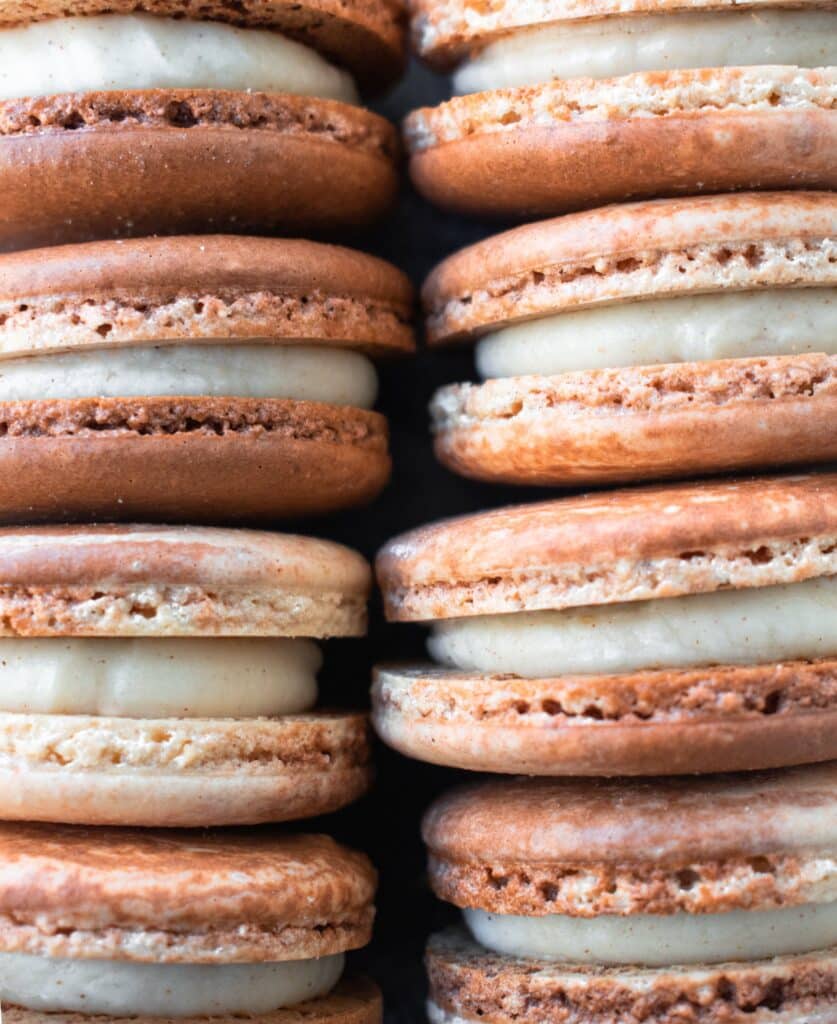These cinnamon bun macarons are light, chewy, and not-too-sweet!

✉️ want to save this?
These macarons were inspired by one of my favorite desserts: cinnamon buns! And now they’re one of the top-selling items on my menu, alongside my Ferrero Rocher macarons.
To give the macarons an extra boost of cinnamon flavor, I added cinnamon powder to the shells and cream cheese frosting. I thought it would be fitting to also add a cinnamon swirl design, which I did by combining brown and white macaron batter before piping the shells.
Once I added my dry ingredients to my meringue, I folded the batter until the almond flour + powdered sugar were fully incorporated. Then, I split the batter into two bowls and added brown or white gel food coloring. I transferred the batters into their own small-medium piping bags, snipped the ends, and put both into a large piping bag fitted with a round tip. When I piped the batter, I held my piping bag at a 90° angle to the baking mat. I made the slight swirl design by moving my piping bag in a circular motion right before I finished piping the shell.

A more detailed post on how I make macarons can be found here. There, you can find pictures/GIFs on how I made chocolate coffee macarons with lavender + white swirls.
If you make cinnamon bun French macarons, I’d love to see your creations—tag me at #bitesbybianca / @bitesbybianca on Instagram! Enjoy! 🙂
Cinnamon Bun French Macarons
✉️ want to save this?
Ingredients
For the French macaron shells:
- 50 g egg whites, room temperature ($0.24)
- 40 g granulated sugar ($0.08)
- ⅛ tsp cream of tartar ($0.04)
- 60 g almond flour, sifted ($1.13)
- 50 g powdered sugar, sifted ($0.22)
- ¼ tsp cinnamon powder ($0.05)
For the cream cheese frosting:
- 3 oz cream cheese, room temperature ($0.71)
- 23 g powdered sugar ($0.23)
- 1 tbsp heavy cream ($0.04)
- ¼ tsp cinnamon powder or more to taste ($0.05)
- pinch of salt ($0.01)
Instructions
Preparation:
- Put printed macaron template on baking trays. Place silicone baking mats or parchment paper on top of templates.
- Set up two small-medium piping bags without tips. Each bag will be for one color. Set up one large piping bag with a large round tip. If you do not have a round tip, you can just snip the end of the bag before piping.
For the French macaron shells:
- In a medium bowl, mix the cinnamon, sifted almond flour, and powdered sugar.
- In a small bowl, combine granulated sugar and cream of tartar.
- Pour the egg whites into the bowl of a stand mixer. Set up a stopwatch to time how long to whip the meringue. 0:00 – 4:00 minutes: Mix on medium-low for 4 minutes (Kitchenaid speed 4).4:00 – 9:30 minutes: Turn the mixer to medium speed (Kitchenaid speed 6). Add a third of the granulated sugar and cream of tartar mixture. After 30 seconds, add another third. After another 30 seconds, add the last of the granulated sugar and cream of tartar mixture. Keep mixing at medium speed until you have reached a total of 9:30 minutes. The meringue should be balled up onto the whisk, glossy, and have stiff peaks. If not, keep mixing at 20-second intervals at Kitchenaid speed 8 until it is.
- Add all of the powdered sugar and almond flour to the meringue. Gently fold the macaron batter, often scraping the sides and bottom of the bowl. Once it is all just combined (no powder remaining), equally separate the batter into two bowls.
- Keeping the other bowl covered, add your gel/powder food coloring of choice to the batter you will first mix. Fold the batter until it reaches a thick, glossy consistency and flows off the rubber spatula into ribbons. To test if it is ready, allow the batter to flow off the spatula and into the batter. If the ribbons do not melt into the rest of the batter after 30 seconds, continue folding. Be careful not to over mix. When it passes this test, transfer the batter to the small/medium piping bag.
- Repeat the last step with the remaining batter.
- Cut the tips of each piping bag and place them into the large piping bag fitted with a round tip. Pipe the macarons onto your silicone mats/parchment paper, using your template as a guide.
- After piping the macarons, tap the trays against the counter a few times. If there are bubbles on the surface, you can use a toothpick or cookie scribe to pop them. Popping the air bubbles helps stop them from cracking when being baked. Remove templates.
- Allow the macarons to sit out at room temperature to dry for at least one hour. They will be ready to bake once the surface of the macaron is matte and dry to the touch. If it is a really humid day, it can sometimes take 2 hours for them to dry.
- Preheat the oven to 325F. Place an empty baking sheet upside-down on the middle rack.
- Place the baking sheet with the macarons on top of the upside-down baking sheet. Bake for 15-20 minutes, rotating halfway through. To test if they are done baking, gently push the side of one shell. If it wiggles on the sheet, they need to be baked longer.
- Remove the macarons and place them on a wire rack. Bake the remaining macaron shells.
- Allow macarons to fully cool before peeling them off the parchment paper or silicone mats.
For the cream cheese frosting:
- Whip the cream cheese and powdered sugar on medium speed until light and fluffy, about 3-4 minutes.
- Add the heavy cream, cinnamon powder, and salt. Whip for another 2-3 minutes.
- Transfer frosting to a piping bag.
Assembly:
- Match the macaron shells. Pipe a dollop of the cream cheese frosting on the bottom shell, then add the other shell on top.
- Leave macarons in an airtight container in the fridge for at least 24 hours before eating. This allows them to mature, making them softer, chewier, and more flavorful. Eat at room temperature.


